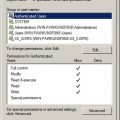When I start to use Windows 2008 with IIS 7, I can not find the place to change time of script.
I have a ASP page which will go through whole database about 20MB, and retrieve the result and put into another database. Sometimes it takes about 3 minutes to finish.
I know how to change the IIS settings in IIS 5 and IIS 6. Now it is 7, I am lost.
Later I found the help page from Microsoft IIS site.
It describe the all limits settings of IIS 7.
The bufferingLimit attribute sets the maximum size of the ASP buffer. If response buffering is turned on, this attribute controls the maximum number of bytes that an ASP page can write to the response buffer before a flush occurs.
The maxRequestEntityAllowed attribute specifies the maximum number of bytes allowed in the entity body of an ASP request. If a Content-Length header is present and specifies an amount of data greater than the value of maxRequestEntityAllowed, IIS returns an HTTP 403 error response.
The processorThreadMax attribute specifies the maximum number of worker threads per processor that IIS may create.
Note: This setting can dramatically influence the scalability of your Web applications and the performance of your server in general. Because this attribute defines the maximum number of ASP requests that can execute simultaneously, this setting should remain at the default value unless your ASP applications are making extended calls to external components.
The queueConnectionTestTime attribute specifies the number of seconds that a request can be queued before ASP determines whether the client is still connected. If the request is queued longer than the number of seconds specified by the queueConnectionTestTime attribute, ASP checks to determine whether the client is still connected before executing the request. If the client is no longer connected, the request is not processed and is deleted from the queue.
Note: Most often, users do not wait more than a few seconds for ASP pages to process. Although the maximum waiting time varies from user to user, the generally accepted maximum is approximately 10 seconds. You can use the queueConnectionTestTime attribute to ensure that IIS does not waste time processing a request that has been abandoned by the user. This attribute is useful for making ASP processing efficient only up to the point at which ASP begins to process the script. Once the script is running, however, your application should continue to check for client connection at appropriate times by using the IsClientConnected method of the ASP built-in Response object.
The queueTimeout attribute specifies the amount of time (in seconds) that an ASP script request is allowed to wait in the queue. When requests are pulled from the queue, they are checked to see if they have expired (have waited longer than the value of this parameter). Expired requests are rejected with a message indicating the server is too busy.
The requestQueueMax attribute specifies the maximum number of concurrent ASP requests that are permitted into the queue. Any client browser that attempts to request ASP files when the queue is full is sent an HTTP 500 Server Too Busy error.
The scriptTimeout attribute specifies (in seconds) the default length of time that ASP pages allow a script to run before terminating the script and writing an event to the Windows Event Log. ASP scripts can override this value by using the ScriptTimeout property of the ASP built-in Session object. The ScriptTimeout property allows your ASP applications to set a higher script time-out value. For example, you can use this setting to adjust the time-out once a particular user establishes a valid session by logging in or ordering a product.
Here is the link for the original page.


